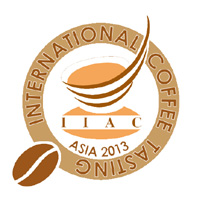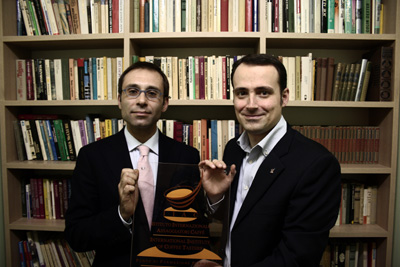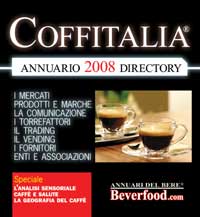by Roberto Sala
Barista. His bar, the Mary’s Bar in Costa Masnaga, in the North of Italy, was set up by his great-grandparents in 1928. He was brought up surrounded by machines, bags and cups. Fifteen years ago he started his job behind the counter: from 2001, he is a coffee taster and Espresso Italiano Specialist.In February 2007, he has been appointed to the board of the International Institute of Coffee Tasters. He is the first barista who has been appointed to such a role.
 How do you become a barista in Italy? The reply to this question might surprise several non-Italian colleagues. As for any job, there are people who choose it and other who wind up doing it, almost by chance, but then they find out that it’s a fantastic job and fall in love with it. Then there are those who do it carelessly and they make, form morning to evening, horrible espressos and cappuccinos – maybe without even realising it. As for any other job, formal training is very important. Before being told that I am being too obvious, I would like to introduce one of the problems of the HoReCa sector in Italy: training.
How do you become a barista in Italy? The reply to this question might surprise several non-Italian colleagues. As for any job, there are people who choose it and other who wind up doing it, almost by chance, but then they find out that it’s a fantastic job and fall in love with it. Then there are those who do it carelessly and they make, form morning to evening, horrible espressos and cappuccinos – maybe without even realising it. As for any other job, formal training is very important. Before being told that I am being too obvious, I would like to introduce one of the problems of the HoReCa sector in Italy: training.
The point is not that there are no courses; actually, there is plenty of offer. When I started this job 15 years ago, there was not that much, it is increasing now. We have courses offered by many organisations, first and foremost by professional schools for the food and hotel sector (where, unfortunately, too little time is devoted to the bar). Then there are the courses, with varying levels of competence and seriousness, proposed by the roasters. So we can say that at present, compared to the past, there are courses for just about any taste and any wallet.
Where is the problem? Here it goes: all too often several issues are dealt with in general terms. This makes them lose the focus and you are left with the idea that just scratched the surface of a lot of issues. In addition, all too often, theory wins on practice. This happens also in courses that are meant to be more focused on doing things. A typical example of this is coffee courses: in those I have attended, I would have appreciated a greater focus on doing things, something which is crucial for the daily activity in the bar.
In Italy, it might be difficult to make the right pick not only for the would-be baristas but also for the experienced ones. This is a problem that must be faced uphill, by carefully thinking of what we want the core business of our bar to be. This makes it possible to rate the courses according to the contribution they can make in the short-to-medium term to our activity. After which, we can upgrade the knowledge we have with other courses. Then, we must keep ourselves continually updated: books, magazines, DVDs, the Internet. Any source that might give information on techniques, trends and new products is more than welcome.
Apart from the courses, we can learn lessons from our colleagues. At the beginning of my career, I decided to acquire experience working in other coffee shops. My family has a bar from more than 100 years, but I did not want to immediately grow roots in our family business. I did some training in other coffee bars. Looking at other baristas doing their job was extremely useful for me. Even today, I take any occasion to drink a coffee prepared by other colleagues just to give at look at how things go in their coffee shops and spot things I might improve in my own.
As for any job, curiosity is of paramount importance: be curious!



 Coffitalia 2008, the new yearbook dedicated to coffee in Italy, recently published by Beverfood, provides the picture and an update of the entire sector with precise and careful references to the markets, competition, the companies and the products.
Coffitalia 2008, the new yearbook dedicated to coffee in Italy, recently published by Beverfood, provides the picture and an update of the entire sector with precise and careful references to the markets, competition, the companies and the products. After Coffee Taster reported Starbucks plans to open 150 new stores in Europe, a number of Italian readers wrote to us to know how they can open and run a Starbucks shop in Italy. Coffee Taster asked the question to Mrs Bridget Baker, Starbucks spokeswoman.
After Coffee Taster reported Starbucks plans to open 150 new stores in Europe, a number of Italian readers wrote to us to know how they can open and run a Starbucks shop in Italy. Coffee Taster asked the question to Mrs Bridget Baker, Starbucks spokeswoman. Without competition, there can be no improvement. This is a genetics law but it is true also for the business world. However, many companies in the coffee sector are not that keen on competition, especially if it is on the sensory impact of the blends. Think about wine, a product from which coffee should draw inspiration if it wants to a step further towards the life of consumers. There is an incredible number of guides with all sorts of comments – expressed in differing ways – valuations at exaggerated rhythms and competitions with tens of editions left behind.
Without competition, there can be no improvement. This is a genetics law but it is true also for the business world. However, many companies in the coffee sector are not that keen on competition, especially if it is on the sensory impact of the blends. Think about wine, a product from which coffee should draw inspiration if it wants to a step further towards the life of consumers. There is an incredible number of guides with all sorts of comments – expressed in differing ways – valuations at exaggerated rhythms and competitions with tens of editions left behind. How do you become a barista in Italy? The reply to this question might surprise several non-Italian colleagues. As for any job, there are people who choose it and other who wind up doing it, almost by chance, but then they find out that it’s a fantastic job and fall in love with it. Then there are those who do it carelessly and they make, form morning to evening, horrible espressos and cappuccinos – maybe without even realising it. As for any other job, formal training is very important. Before being told that I am being too obvious, I would like to introduce one of the problems of the HoReCa sector in Italy: training.
How do you become a barista in Italy? The reply to this question might surprise several non-Italian colleagues. As for any job, there are people who choose it and other who wind up doing it, almost by chance, but then they find out that it’s a fantastic job and fall in love with it. Then there are those who do it carelessly and they make, form morning to evening, horrible espressos and cappuccinos – maybe without even realising it. As for any other job, formal training is very important. Before being told that I am being too obvious, I would like to introduce one of the problems of the HoReCa sector in Italy: training.
